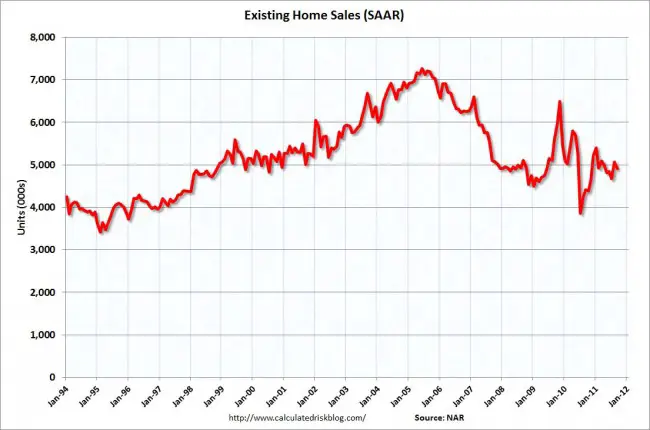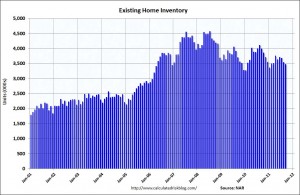
Existing-home sales were down in September on the heels of a strong gain in August, but remain well above a year ago, according to the National Association of Realtors.
Total existing-home sales1, which are completed transactions that include single-family, townhomes, condominiums and co-ops, declined 3.0 percent to a seasonally adjusted annual rate of 4.91 million in September from an upwardly revised 5.06 million in August, but are 11.3 percent above the 4.41 million unit pace in September 2010.
Lawrence Yun, NAR chief economist, said the market has been stable although at low levels, and there is plenty of room for improvement. “Existing-home sales have bounced around this year, staying relatively close to the current level in most months,” he said. “The irony is affordability conditions have improved to historic highs and more creditworthy borrowers are trying to purchase homes, but the share of contract failures is double the level of September 2010. Even so, the volume of successful buyers is higher than a year ago and is remaining fairly stable – this speaks to an unfulfilled demand.”
According to Freddie Mac, the national average commitment rate for a 30-year, conventional, fixed-rate mortgage fell to a record low 4.11 percent in September, down from 4.27 percent in August; the rate was 4.35 percent in September 2010.
Contract failures2 were reported by 18 percent of NAR members in September, unchanged from August; they were 9 percent in September 2010. Contract failures are cancellations caused by declined mortgage applications, failures in loan underwriting from appraised values coming in below the negotiated price, or other problems including home inspections and employment losses.
 NAR President Ron Phipps, broker-president of Phipps Realty in Warwick, R.I., said access to credit is unbalanced. “All year we’ve been discussing the fact that many creditworthy home buyers are being denied mortgages,” he said. “On top of that, loan limits have been lowered, which means buyers of higher priced homes, including many in more expensive housing markets, now have to pay a higher interest rate for a jumbo mortgage than buyers who can qualify for a conventional loan. We need to remove the roadblocks to a housing recovery – not place more obstacles in the way of financially qualified buyers.”
NAR President Ron Phipps, broker-president of Phipps Realty in Warwick, R.I., said access to credit is unbalanced. “All year we’ve been discussing the fact that many creditworthy home buyers are being denied mortgages,” he said. “On top of that, loan limits have been lowered, which means buyers of higher priced homes, including many in more expensive housing markets, now have to pay a higher interest rate for a jumbo mortgage than buyers who can qualify for a conventional loan. We need to remove the roadblocks to a housing recovery – not place more obstacles in the way of financially qualified buyers.”
All-cash sales accounted for 30 percent of purchase activity in September, up from 29 percent in August and 29 percent also in September 2010; investors make up the bulk of cash purchases.
Investors purchased 19 percent of homes in September, down from 22 percent in August; they were 18 percent in September 2010. First-time buyers accounted for 32 percent of transactions in September, unchanged from August; they were also 32 percent in September 2010.
The national median existing-home price3 for all housing types was $165,400 in September, down 3.5 percent from September 2010. Distressed homes – foreclosures and short sales typically sold at deep discounts – accounted for 30 percent of sales in September (18 percent were foreclosures and 12 percent were short sales), down from 31 percent in August and 35 percent in September 2010.
Total housing inventory at the end of September declined 2.0 percent to 3.48 million existing homes available for sale, which represents an 8.5-month supply4 at the current sales pace, compared with an 8.4-month supply in August.
Single-family home sales fell 3.6 percent to a seasonally adjusted annual rate of 4.33 million in September from 4.49 million in August, but are 12.2 percent above the 3.86 million-unit level in September 2010. The median existing single-family home price was $165,600 in September, down 3.9 percent from a year ago.
Existing condominium and co-op sales rose 1.8 percent a seasonally adjusted annual rate of 580,000 in September from 570,000 in August, and are 5.6 percent above the 549,000-unit pace one year ago. The median existing condo price5 was $163,800 in September, which is 1.0 percent below September 2010.
Regionally, existing-home sales in the Northeast rose 2.6 percent to an annual level of 790,000 in September and are 6.8 percent above a year ago. The median price in the Northeast was $229,400, down 3.3 percent from September 2010.

Existing-home sales in the Midwest slipped 0.9 percent in September to a pace of 1.09 million but are 17.2 percent higher than September 2010. The median price in the Midwest was $137,400, which is 1.4 percent below a year ago.
In the South, existing-home sales declined 2.6 percent to an annual level of 1.89 million in September but are 10.5 percent above a year ago. The median price in the South was $144,400, down 3.0 percent from September 2010.
Existing-home sales in the West fell 8.8 percent to an annual pace of 1.14 million in September but are 10.7 percent higher than September 2010. The median price in the West was $207,400, which is 4.5 percent below a year ago.
“The falloff in Western sales from a surge in August was expected because many lenders had lowered mortgage loan limits over concerns that sales wouldn’t close before the higher loan limits expired at the end of the September,” Yun said. “Given the concentration of higher cost housing in the West, particularly in California, many buyers were motivated to close in the months leading up to the changeover while they could still get low interest rates on conventional mortgages. Unless Congress reinstates the higher limits, the overall housing market recovery will be slower than it otherwise could be, and will hold back the broader economic recovery.”





























Leave a Reply